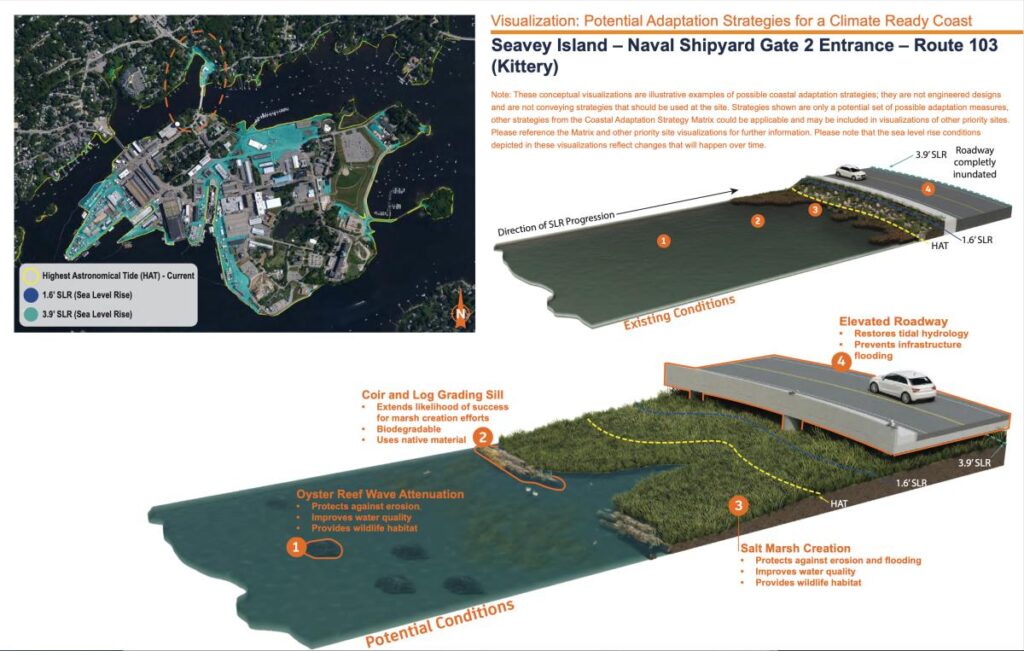Graphic courtesy of Southern Maine Planning and Development Commission
The signs of climate change have been getting worse lately in Maine, with recent storms cutting off access to local roads along the state’s southern coast.
“It gets pretty bad,” said Kittery Town Manager Kendra Amaral in speaking with Portland’s WCSH-TV in late February. “We have anywhere between three and six roads that end up getting cut off that are important thruways for community members and for just general traffic in town when we have storms with high wind and high tide.”
Amaral added that the situation has gotten so bad that she believes something needs to be done before the next coastal flood emergency happens.
Luckily, “The shipyard employees and contractors can get off the island and safely away from the danger area, and our community members can get away from the coast in a safe manner without being blocked by flooded roads,” she said.
Help is on the way.
Abbie Sherwin has been leading the team working on a newly funded project focused on producing designs to increase the resilience of vulnerable roadways in Kittery.
A senior planner and coastal resilience coordinator for the Southern Maine Planning and Development Commission (SMPDC), Sherwin said the effort includes areas like U.S. Highway 1 over Spruce Creek, and Whipple Road over Gate 2 of the Portsmouth Naval Shipyard (PNSY) entrance.
“These two roadway segments are really important for local and regional travel. They’re also emergency and evacuation routes,” she explained. “They provide critical access to and from the Portsmouth Naval Shipyard, but they are also really important from a local commuting perspective. So, they’re important regionally as well as locally.”
To help develop solutions to the problem, the Maine project received a grant totaling $545,700 from the National Fish and Wildlife Foundation, U.S. Department of Defense, and the National Oceanic and Atmospheric Administration (NOAA).
Kittery Roads Susceptible to Sea-Level Rise
A community of 10,000 residents located at the southernmost tip of Maine across a series of islands, Kittery also is home to significant coastal habitat and wildlife, and extremely vulnerable to coastal hazards.
The oldest town in the state, it also has a robust year-round population and the PNSY, a keystone of Kittery’s waterfront, is a critical U.S. military installation — one of only four remaining U.S. Navy repair shipyards in the country.
Two roads in Kittery that are crucial for community travel and access to PNSY are especially vulnerable to sea level rise, SMPDC noted.
“Spruce Creek, a tidal waterbody bordered by saltmarsh intersects those roadways and is threatened by nonpoint source pollution and possible future development,” the Saco, Maine-based SMPDC wrote in a project description. “The project team from SMPDC plans to engage technical experts and local partners to complete a preliminary design of nature-based solutions to address vulnerabilities of Spruce Creek, the two roads, and associated storm and sewer infrastructure and to enhance the resilience of Kittery and the PNSY military operations.”
The commission added that the effort’s activities will include a site assessment of the creek and the roadways to identify conditions, vulnerabilities and opportunities for solutions; a development and evaluation of three conceptual designs, before choosing one to advance; and robust community and stakeholder engagement throughout the process.
Following that, SMPDC will present a plan to include a 60 percent design for the site and a decision, based on collaboration between Kittery and PNSY which, according to Sherwin will help “the community move from the planning stage to get to some designs that will eventually or possibly lead to construction projects to enhance the resilience of the road.”
Solutions to Be Applied to Other Maine Communities
Key roads flooding and becoming impassable during heavy rain events like the region has seen in recent months are among the issues worsening with climate change.
But these problems are not just happening in southern York County.
“We know that vulnerable transportation infrastructure is not unique to Kittery,” Sherwin told WCSH-TV. “It’s a common issue up and down the coastline as was highlighted with the recent storms that we experienced.
“So, part of this project would focus on transferring the information that we glean from this effort but also some of the design aspects on how we could possibly incorporate nature-based solutions into these infrastructure projects and share them with other communities.”
According to Amaral, the town of Kittery is on board.
“This grant was just the appropriate and obvious next step for working on solutions for an area that we’ve identified as being very vulnerable,” she explained.
Read the full article here

